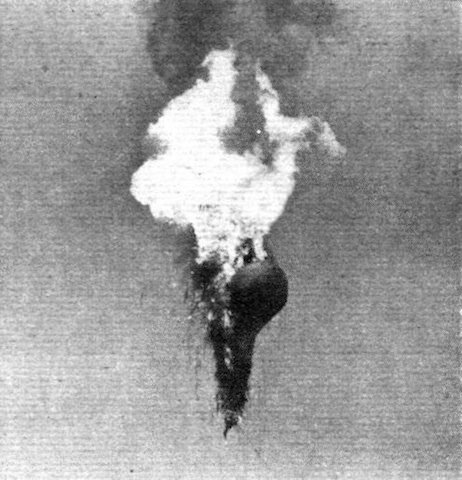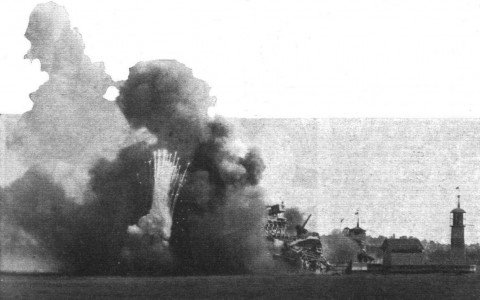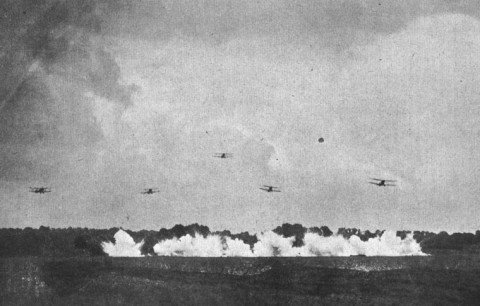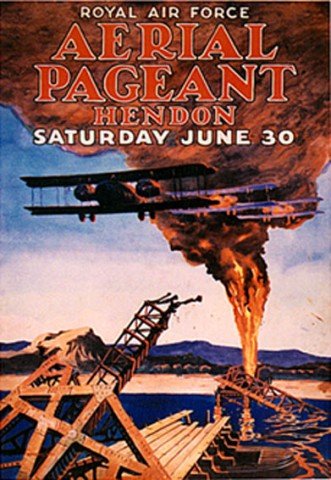My main interest in this series about the RAF Displays at Hendon has been in the set pieces with which they ended. But as this is the last post it's worth looking a bit at the organisation of the Display itself. Flight had some useful articles for this in its preview of the 15th Display, held on Saturday, 29 June 1935. Above is a map showing the aerodrome, the seating arrangements, car parks, access roads and Colindale tube, which opened in 1924 and was a major boon for visitors to the Display.1 (For those who have been to the area more recently -- say to the RAF Museum or British Library Newspapers -- it's interesting to compare how the area has changed.) We can see from the seating plans some of the groups the RAF was trying to impress: there are boxes for the House of Commons, the House of Lords and public schools -- presumably with an eye to future officer recruitment. Private boxes seating six could be booked for between £4 and £7 (depending on location?); at the other end of the spectrum the groundlings could buy tickets for the least exclusive enclosures on the day for 2s., or a spot on a hillside overlooking the aerodrome for 1s.2 Attendance peaked in 1931 at 169,000 (bringing in £27,585 6s. 11d.), though including onlookers sitting in places where they didn't have to pay the figure came up to around 500,000 (or so Flight reckoned).3 The organisation of the Display was a year-round affair, with the 'display office' being closed only for a couple of weeks in August. The programme is 'usually settled fairly exactly by the beginning of the year', but by whom is not clear. The whole thing is overseen by a 'Display Committee' headed by Air Chief Marshal Sir Robert Brooke-Popham; the 'Flying-Subcommittee' chaired by Air Vice-Marshal Joubert de la Ferté handles the exciting bits; and the 'General Purposes Committee', of which Air Commodore B. C. H. Drew is secretary, organises everything else -- ticketing, liaison with transport and police, construction, etc.4
Another reason for talking about the organisation is that this year there was no set piece, only a fly-past. Flight's correspondent wasn't sure why:
In past years the final item of the Display has, as everybody knows, been a "set-piece" in which a fort, munition works, aerodrome, ship or other objective belonging to a nefarious enemy has gone up in flames, smoke and terrific noise, to the general delight. This time, for some reason best known to the organisers, the finale took the form of a fly-past by nine squadrons of machines which had taken part in the display.5
This, it was thought, was 'unimpressive, either by comparison with the finales of previous years or with several items the same afternoon'.4 It would be interesting to know why there was no set-piece; perhaps for some reason such play-acting was no longer acceptable given that tension in Europe was rising and the RAF itself was rearming.
Whatever the reason, the set-piece was back for the next Display (held on Saturday, 27 June 1936). Indeed, there were a couple of mini-mock battles earlier in the programme -- one involved Bristol Bulldogs bombing and strafing marauders from 'an unknown race of white savages' ('in some quarters it is thought less reprehensible to bomb white savages than to employ similar tactics against black men').6 The set-piece itself involved a much more industrialised target:
Southland's power station -- a most solid and convincing edifice on the far side of the aerodrome -- was the objective of Northland's bombers.7
The 'brightening-up' of this year's programme included broadcasting radio transmissions from the participants over loudspeakers for the crowds to hear. So they were able to listen in to 'Southland's operational headquarters receiving raid warnings from ships and the Observer Corps, ordering up its defending fighter squadrons [...] to patrol the expected avenues of attack, and calling on the A.A. guns to stand by in readiness'8.

Northland first sends in a Hawker Hart to shoot down the observation balloon; 'the latter, apparently preferring death to dishonour, burst into flame before the Hart was within range'.4 The commander of one of the defending squadron reports 'we are now engaging the enemy', more Harts, who appear 'out of the heat haze with the defenders and diving in and out among them, and in a few seconds the unlucky power station's volts, amps and ohms are being split into atoms in a terrific welter of smoke, flame and noise'.4
And then the guns are told to stand by for a second raid which will be "here in three minutes -- as you were, in one minute." This time the attackers are two squadron V's of Heyfords; they are engaged by No. 17's Bulldogs, and one descends "in flames," doing a genuine loop -- amazing sight -- in the process, and going down out of sight behind the trees in realistic fashion. But the power station suffers again.4
A Heyford looping would have been very impressive indeed, as it was a big twin-engined machine, the last of the RAF's biplane night bombers. It does sound like Flight's correspondent found the set-piece quite exciting:
Then we learn that the first raid is turning to reopen the attack, and soon the Harts are approaching in echelon, to fall away one after the other in a steep bombing dive.4
A bit oddly, though, the set-piece ends with Southland resigning 'itself to waiting for "another raid at 10 p.m."', even though the power station is already ruined.4 I'm not sure what this was meant to convey to the audience. That the times of air raids can be predicted? That targets will be bombed over and over again until the rubble is turned into dust? That they should stick around for an encore show that evening?
The eighteenth RAF Display was held on Saturday, 26 June 1937. Again, some of the earlier events had scripted scenarios (strafing some river pirates, for example) but the main attraction was again the 'old favourite -- the Set Piece. This year it was more theatrical than usual, and well staged'.9
The erection represented Port Hendon, complete with lighthouse and a ship in dock. The broadcast came from the control room of the Fighter Command, and one heard the reports coming in of a Blueland raid flying inland very fast and evidently making for Port Hendon. The A.O.C. ordered up No. 3 (Fighter) Squadron to meet it, and we saw the Gladiators (Mercury engines) leap into the sky and make off for their patrol line. Then came in reports of a second raid, and yet a third. After waiting a moment to make sure of its direction, the A.O.C. sent up No. 601 (County of London) (Fighter) Squadron to deal with it, and off went the Auxiliaries in their Demons (Kestrels).4
The first wave of bombers were Bristol Blenheims, which easily dodged the Gladiators, though 'Archie' got one ('Bravo the Territorial Army!')10 Hawker Hinds were intercepted by the Demons, but the port took some damage (as seen in the Pathe Gazette newsreel above).
Meantime some Vildebeests of No. 42 (Torpedo Bomber) Squadron, very proud of their new sleeve-valve Perseus engines, came in low and torpedoed the lock gates, to the discomfiture of the ship inside.11
The coup de grâce was delivered by five Vickers Wellesleys ('very shapely'!) and five Armstrong-Whitworth Whitleys ('impressive').4
When they had finished, Port Hendon was a sorry mess, but everyone was tremendously cheered to hear that our own bombers had just demolished the chief aero engine factory of Blueland. "That," remarked the A.O.C., "will keep them quiet for a while." The reflection did not seem to console the O.C. Port Hendon, but it did rub it in that after all British bombers are our defenders.12
Yes, take that the Fighter Command and also pacifists!
The eighteenth RAF Display was also the last. In January 1938 the Air Council announced that it would no longer be held. The reason given was that the faster aeroplanes now in service meant that it was now too hard for Hendon to be the 'culminating point for the training of squadrons stationed in this country':
A large part of the attraction of the display has been the presentation of intricate evolutions in a comparatively confined space within clear view of all the spectators. The advent of new aircraft of greatly increased power and speed has led to the development of new technique [sic] in training and tactics. If, therefore, the display was to maintain a real connection with the Service training of the Air Force, its character would have to be radically altered. The aircraft taking part would need to manœuvre over a much wider area, and its attractiveness would thus be greatly diminished. For these and other reasons, Hendon is obviously unsuitable.13
These 'other reasons' may have included the need to focus more squarely on preparing for war; and perhaps also a feeling that, after Guernica and the other air raids on civilian targets in Spain, mock bombing wasn't suitable entertainment for the masses.
I'll probably write another, more reflective post on the Hendon set-pieces. But not today!
![]() This work is licensed under a Creative Commons Attribution-NonCommercial-NoDerivatives 4.0 International License.
Permissions beyond the scope of this license may be available at http://airminded.org/copyright/.
This work is licensed under a Creative Commons Attribution-NonCommercial-NoDerivatives 4.0 International License.
Permissions beyond the scope of this license may be available at http://airminded.org/copyright/.
- Flight, 27 June 1935, 725. [↩]
- Ibid., 726; the map is from here also. [↩]
- Ibid., 727. [↩]
- Ibid. [↩] [↩] [↩] [↩] [↩] [↩] [↩] [↩] [↩]
- Ibid., 4 July 1935, 11. [↩]
- Ibid., 2 July 1936, 8. [↩]
- Ibid., 11. The illustrations are from ibid., 10. [↩]
- Ibid., 11. [↩]
- Ibid., 1 July 1937, 10. [↩]
- Ibid. The illustrations are from here and ibid., 11. [↩]
- Ibid., 10. [↩]
- Ibid; emphasis added. [↩]
- Ibid., 27 January 1938, 94. [↩]










JDK
Re- Heyfords aerobatting, from my article in the Aircrew series in Aeroplane magazine:
"It was apparently ‘lovely to fly’ – relatively viceless and with easy controls. While not officially aerobatic, the Heyford could be thrown about with some abandon, and was even looped, in public, at the 1935 Hendon RAF Display. A number were fitted with an autopilot (‘George’ enabled ‘pilotless’ Heyfords to trick unsuspecting Gauntlet pilots) – and the pilot could pass control of the Heyford to the bomb-aimer who could direct the aircraft using the steering control of the automatic pilot. Due to the excellent visibility and control characteristics, Bomber Squadrons often flew tight and impressive formations."
Brett Holman
Post authorYes, I found references to the 1935 Heyford loop online; apparently it was a vic of Heyfords looping in unison? Oddly, though, I couldn't find anything about it in Flight.
JDK
I shall check my refs...
Pingback:
Airminded · Comparing Hendon
Rob Langham
As ever, very interesting post - nice map too, I used to live in the building marked out just under Enclosure 7 - the building was built in 1917 as the RFC Officers Mess to a lovely mock-tudor design, and was then from what I can gather a (or the) hotel, but when I stayed there it had been mostly converted inside to student accomodation
Brett Holman
Post authorThanks, Rob. I see you've posted some photos of this building on the Aerodrome Forum -- it's surprising that it has survived all the redevelopment that has gone on in Hendon since 1945!
Chris Williams
I've just been writing a little bit about some of that rebuilding, when the Met put the Police National Computer there in 1972. Lovely story of a very low bid leading to a very broke contractor. Luckily the immense software delays wholly concealed the merely huge estates delays.
Pingback:
Port Adelaide
Pingback:
Gaming the knock-out blow — III | Airminded
Pingback:
Pulp aviation – Airminded
Pingback:
The year for a trip Home – Airminded